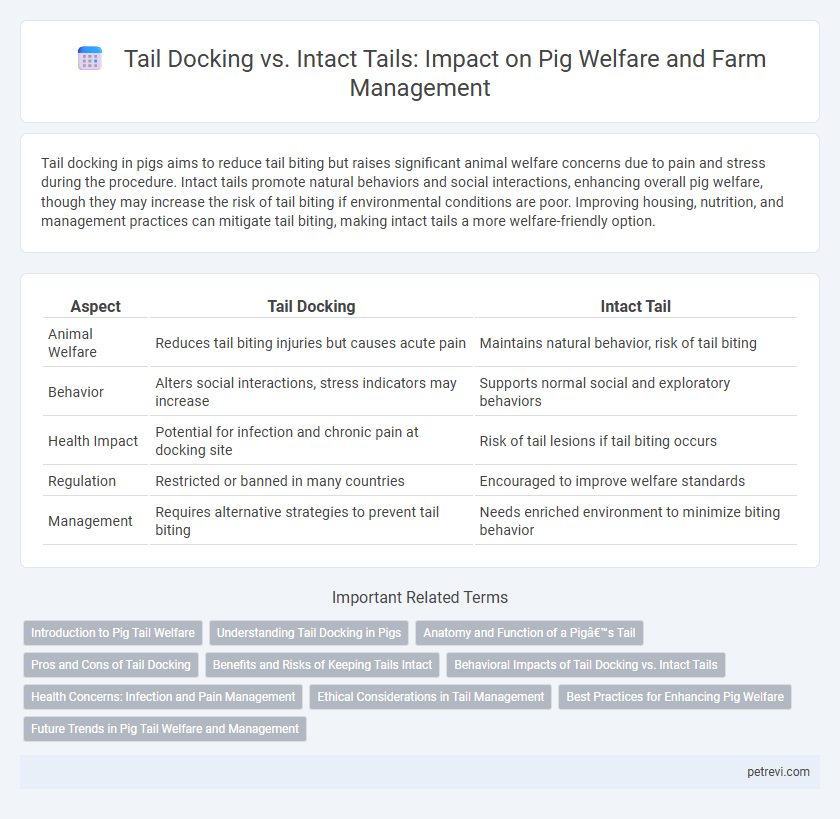Tail docking in pigs aims to reduce tail biting but raises significant animal welfare concerns due to pain and stress during the procedure. Intact tails promote natural behaviors and social interactions, enhancing overall pig welfare, though they may increase the risk of tail biting if environmental conditions are poor. Improving housing, nutrition, and management practices can mitigate tail biting, making intact tails a more welfare-friendly option.
Table of Comparison
| Aspect | Tail Docking | Intact Tail |
|---|---|---|
| Animal Welfare | Reduces tail biting injuries but causes acute pain | Maintains natural behavior, risk of tail biting |
| Behavior | Alters social interactions, stress indicators may increase | Supports normal social and exploratory behaviors |
| Health Impact | Potential for infection and chronic pain at docking site | Risk of tail lesions if tail biting occurs |
| Regulation | Restricted or banned in many countries | Encouraged to improve welfare standards |
| Management | Requires alternative strategies to prevent tail biting | Needs enriched environment to minimize biting behavior |
Introduction to Pig Tail Welfare
Pig tail welfare is a critical aspect of overall animal health and behavior. Tail docking, the removal of part of the pig's tail, is commonly practiced to prevent tail biting, a harmful behavior linked to stress and overcrowding. Maintaining intact tails supports natural pig behaviors and improves welfare by reducing pain and promoting social interaction.
Understanding Tail Docking in Pigs
Tail docking in pigs involves the removal of a portion of the tail to prevent tail biting, a common behavioral problem in intensive pig farming. This practice is often performed within the first week of life, aiming to reduce injuries and infections caused by tail biting among pigs housed in confined environments. Understanding the implications of tail docking helps in evaluating its effects on pig welfare and exploring alternative management strategies.
Anatomy and Function of a Pig’s Tail
A pig's tail plays a crucial role in communication, balance, and thermoregulation, with its anatomy comprising vertebrae, muscles, and nerves that support these functions. Tail docking, the removal of part of the tail, disrupts these natural physiological and behavioral roles, potentially causing chronic pain and stress. Maintaining an intact tail preserves sensory input and social signaling, essential for overall pig welfare and reducing aggressive behaviors such as tail biting.
Pros and Cons of Tail Docking
Tail docking in pigs reduces the risk of tail biting injuries and infections, leading to improved overall herd health and reduced veterinary costs. However, this practice causes acute pain and stress during the procedure, potentially affecting pig welfare negatively. Maintaining intact tails supports natural behaviors and welfare but requires enhanced management practices to prevent tail biting outbreaks.
Benefits and Risks of Keeping Tails Intact
Keeping pig tails intact reduces the risk of chronic pain associated with tail docking, promoting natural behaviors and social interactions that enhance overall welfare. Intact tails enable pigs to communicate distress and health status effectively, which can lead to early detection of illness or injury. However, the risk of tail biting increases without docking, potentially causing severe wounds and infections if not managed with appropriate environmental enrichment and stocking density.
Behavioral Impacts of Tail Docking vs. Intact Tails
Tail docking in pigs reduces tail biting incidents but can lead to increased stress and altered social behaviors, including heightened aggression and abnormal oral activities. Intact tails allow natural tail movement, promoting normal social interactions and exploratory behaviors, enhancing overall welfare by reducing fear and frustration. Behavioral studies indicate that maintaining intact tails supports better psychological well-being, whereas tail docking may compromise welfare by disrupting natural behaviors.
Health Concerns: Infection and Pain Management
Tail docking in pigs is commonly performed to reduce tail biting incidents but raises significant health concerns related to infection and pain management. The procedure can cause acute pain and increase susceptibility to infections at the docking site, impacting overall pig welfare. Maintaining intact tails, combined with environmental enrichment and proper management, helps minimize stress and injury while supporting natural behaviors.
Ethical Considerations in Tail Management
Tail docking in pigs raises significant ethical concerns due to its potential to cause pain and stress, undermining animal welfare principles that prioritize minimizing harm. Maintaining intact tails aligns with welfare ethics by preserving natural behaviors and reducing the risk of chronic pain associated with docking procedures. Ethical tail management advocates emphasize environmental enrichment and proper housing to prevent tail biting, promoting welfare without resorting to invasive practices.
Best Practices for Enhancing Pig Welfare
Tail docking in pigs, a common practice to prevent tail biting, raises significant welfare concerns due to pain and stress caused by the procedure. Maintaining intact tails supports natural behaviors and social interactions, but requires implementing environmental enrichments, proper stocking density, and health management to minimize tail biting incidents. Best practices for enhancing pig welfare prioritize providing straw bedding, adequate space, and consistent monitoring to ensure both physical health and psychological well-being.
Future Trends in Pig Tail Welfare and Management
Future trends in pig tail welfare emphasize the reduction of tail docking practices through genetic selection for less aggressive behaviors and enhanced environmental enrichment to minimize tail biting incidents. Innovations in precision livestock farming, including real-time monitoring systems, enable early detection of stress and tail biting, promoting proactive management strategies. Research advances and welfare regulations increasingly support intact tail retention as a standard, improving overall pig health and ethical farming practices.
Tail Docking vs Intact Tail for Pig Welfare Infographic

 petrevi.com
petrevi.com